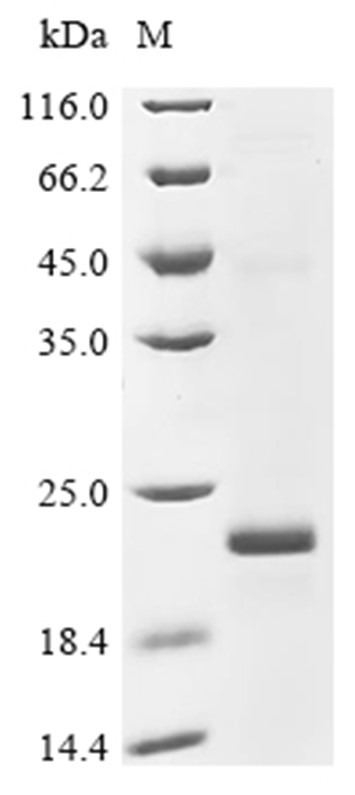Shopping Cart
Remove All Your shopping cart is currently empty
Your shopping cart is currently empty
IL-17A Protein, Rat, Recombinant (His) is expressed in E. coli expression system with N-6xHis tag. The predicted molecular weight is 21.0 kDa and the accession number is Q61453.

| Pack Size | Price | USA Warehouse | Global Warehouse | Quantity |
|---|---|---|---|---|
| 5 μg | $89 | 20 days | 20 days | |
| 10 μg | $143 | 20 days | 20 days | |
| 20 μg | $237 | 20 days | 20 days | |
| 50 μg | $358 | 20 days | 20 days | |
| 100 μg | $490 | - | In Stock | |
| 200 μg | $755 | 20 days | 20 days | |
| 500 μg | $1,330 | 20 days | 20 days | |
| 1 mg | $2,080 | 20 days | 20 days |
| Biological Activity | Activity has not been tested. It is theoretically active, but we cannot guarantee it. If you require protein activity, we recommend choosing the eukaryotic expression version first. |
| Description | IL-17A Protein, Rat, Recombinant (His) is expressed in E. coli expression system with N-6xHis tag. The predicted molecular weight is 21.0 kDa and the accession number is Q61453. |
| Species | Rat |
| Expression System | E. coli |
| Tag | N-6xHis |
| Accession Number | Q61453 |
| Synonyms | Interleukin-17A,IL-17A,Il17a,IL-17,Il17,Cytotoxic T-lymphocyte-associated antigen 8 (CTLA-8),Ctla8 |
| Amino Acid | AVLIPQSSVCPNAEANNFLQNVKVNLKVINSLSSKASSRRPSDYLNRSTSPWTLSRNEDPDRYPSVIWEAQCRHQRCVNAEGKLDHHMNSVLIQQEILVLKREPEKCPFTFRVEKMLVGVGCTCVSSIVRHAS |
| Construction | 18-150 aa |
| Protein Purity | > 90% as determined by SDS-PAGE.  |
| Molecular Weight | 21.0 kDa (predicted) |
| Endotoxin | < 1.0 EU/μg of the protein as determined by the LAL method. |
| Formulation | If the delivery form is liquid, the default storage buffer is Tris/PBS-based buffer, 5%-50% glycerol. If the delivery form is lyophilized powder, the buffer before lyophilization is Tris/PBS-based buffer, 6% Trehalose, pH 8.0. |
| Reconstitution | Reconstitute the lyophilized protein in sterile deionized water. The product concentration should not be less than 100 μg/mL. Before opening, centrifuge the tube to collect powder at the bottom. After adding the reconstitution buffer, avoid vortexing or pipetting for mixing. |
| Stability & Storage | Lyophilized powders can be stably stored for over 12 months, while liquid products can be stored for 6-12 months at -80°C. For reconstituted protein solutions, the solution can be stored at -20°C to -80°C for at least 3 months. Please avoid multiple freeze-thaw cycles and store products in aliquots. |
| Shipping | In general, Lyophilized powders are shipping with blue ice. Solutions are shipping with dry ice. |
| Research Background | Effector cytokine of innate and adaptive immune system involved in antimicrobial host defense and maintenance of tissue integrity. Signals via IL17RA-IL17RC heterodimeric receptor complex, triggering homotypic interaction of IL17RA and IL17RC chains with TRAF3IP2 adapter. This leads to downstream TRAF6-mediated activation of NF-kappa-B and MAPkinase pathways ultimately resulting in transcriptional activation of cytokines, chemokines, antimicrobial peptides and matrix metalloproteinases, with potential strong immune inflammation. Plays an important role in connecting T cell-mediated adaptive immunity and acute inflammatory response to destroy extracellular bacteria and fungi. As a signature effector cytokine of T-helper 17 cells (Th17), primarily induces neutrophil activation and recruitment at infection and inflammatory sites. In airway epithelium, mediates neutrophil chemotaxis via induction of CXCL1 and CXCL5 chemokines. In secondary lymphoid organs, contributes to germinal center formation by regulating the chemotactic response of B cells to CXCL12 and CXCL13, enhancing retention of B cells within the germinal centers, B cell somatic hypermutation rate and selection toward plasma cells. Effector cytokine of a subset of gamma-delta T cells that functions as part of an inflammatory circuit downstream IL1B, TLR2 and IL23A-IL12B to promote neutrophil recruitment for efficient bacterial clearance. Effector cytokine of innate immune cells including invariant natural killer cell (iNKT) and group 3 innate lymphoid cells that mediate initial neutrophilic inflammation. Involved in the maintenance of the integrity of epithelial barriers during homeostasis and pathogen infection. Upon acute injury, has a direct role in epithelial barrier formation by regulating OCLN localization and tight junction biogenesis. As part of the mucosal immune response induced by commensal bacteria, enhances host's ability to resist pathogenic bacterial and fungal infections by promoting neutrophil recruitment and antimicrobial peptides release. In synergy with IL17F, mediates the production of antimicrobial beta-defensins DEFB1, DEFB103A, and DEFB104A by mucosal epithelial cells, limiting the entry of microbes through the epithelial barriers. Involved in antiviral host defense through various mechanisms. |
| Size | Quantity | Unit Price | Amount | Operation |
|---|

Copyright © 2015-2025 TargetMol Chemicals Inc. All Rights Reserved.